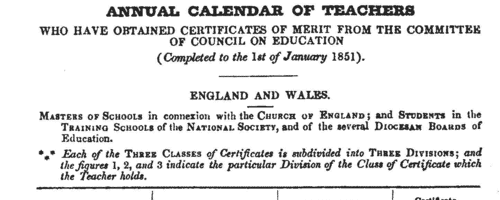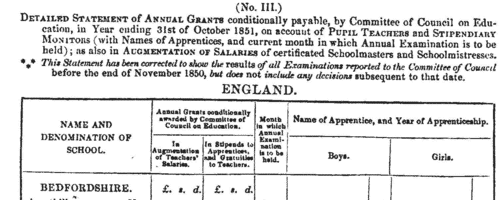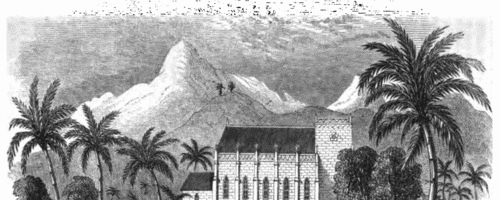Vickery Surname Ancestry ResultsOur indexes 1000-1999 include entries for the spelling 'vickery'. In the period you have requested, we have the following 300 records (displaying 111 to 120): Single Surname Subscription | | | Buying all 300 results of this search individually would cost £1,706.00. But you can have free access to all 300 records for a year, to view, to save and print, for £100. Save £1,606.00. More... |
These sample scans are from the original record. You will get scans of the full pages or articles where the surname you searched for has been found. Your web browser may prevent the sample windows from opening; in this case please change your browser settings to allow pop-up windows from this site. Inhabitants of Aston in Warwickshire
(1850)
Francis White & Co.'s History, Gazetteer, and Directory of Warwickshire for 1850 lists nobility, gentry, clergy, other private residents and traders, hundred by hundred and village by village, with separate sections for the large towns.VICKERY. Cost: £6.00.  | Sample scan, click to enlarge

| Non-conformist Schoolmasters
(1850)
The Committee of Council on Education awarded certificates of merit to teachers throughout Britain, and published annual lists of those qualifying in the previous years. Masters and mistresses are listed separately, with surname and initials, and school at which teaching, post town or county, and grade of the certificate: each of the three classes of certificate being subdivided into three. There are five separate lists for masters and mistresses:
1. Teachers in schools in connexion with the Church of England; male students in the Training Schools of the National Society, and of the several Diocesan Boards of Education; and female students in the Training Schools of the National Society (Whitelands, Chelsea), the Home and Colonial School Society (Gray's Inn Road, Holborn), and the Salisbury and York and Ripon Diocesan Boards of Education.
2. Teachers, in England and Wales, of British, Wesleyan and other Protestant Schools, not in connexion with the Church of England;
3. Teachers, in England and Wales, of Roman Catholic Schools;
4. Teachers of schools in Scotland, in connexion with the Established Church; male students in the Edinburgh and Glasgow Training Colleges; and female students in training schools.
5. Teachers of schools in Scotland, not in connexion with the Established Church; male students in the Training Schools of the Free Church (at Edinburgh and Glasgow); and female students in training schools.
This is the list, corrected to 1 January 1851, published in 1851.VICKERY. Cost: £4.00.  | Sample scan, click to enlarge

|  Inhabitants of Newington in Surrey
(1851) Inhabitants of Newington in Surrey
(1851)
The 1851 census return for St Mary Newington, Surrey, registration district: St Peter Walworth sub-district: enumeration district 19: described as: "All that Part of the Parish of St. Mary Newington, which Comprises The East side of Walworth Road from Trafalgar St. to East St. South side of East St., to Richmond St., and West side of Richmond St. to George St., Including Bronti Place, Walworth Gardens, Walworth Place, & Beckford Place". This area lay in the ecclesiastical district of St Peter Walworth, and in the borough of Lambeth. HO 107/1567. The addresses listed in the actual returns are 1 to 26 Beckford Row; 1 to 44 East Street (including Good Intent beerhouse and Joiners Arms beerhouse); 1 to 4 Gloucester Place (including Royal George beerhouse); 22 to 30 Richmond Street, East Street; 1 to 41 Bronti Place; 1 to 14 Walworth Gardens, East Street; 1 to 8 Walworth Place; and 1 to 6 Beckford Place.VICKERY. Cost: £4.00.  | Sample scan, click to enlarge

| Pupil Teachers in Hampshire: Girls
(1851)
The Committee of Council on Education awarded annual grants for the training and support of pupil teachers and stipendiary monitors in schools in England, Wales, Scotland, the Isle of Man and the Channel Islands. Pupil teachers started training between the ages of 13 and 15, and 'must not be subject to any bodily infirmity likely to impair their usefulness as Pupil Teachers, such as scrofula, fits, asthma, deafness, great imperfections in the sight or voice, the loss of an eye from constitutional disease, or the loss of an arm or leg, or the permanent disability of either arm or leg, curvature of the spine, or a hereditary tendency to insanity'.
They also had to obtain certificates from the managers of the school (and their clergyman, in the case of Church of England schools) as to their moral character and that of their family; good conduct; punctuality, diligence, obedience, and attention to duty; and attentiveness to their religious duties.
This detailed statement in the annual report of the committee for the year ending 31 October 1851 lists schools by county, giving:
1. Name and Denomination of School, with these abbreviations - B, British and Foreign School Society; F. C., Free Church of Scotland; H. C., Home and Colonial School Society; N., National Society, or connected with the Church of England; R. C., Roman Catholic Poor-School Committee; Wesn., Wesleyan Methodist.
2. Annual grants conditionally awarded by the committee in augmentation of teachers' salaries, and in stipends to apprentices, and gratuities to teachers.
3. Month in which annual examination was to be held.
4. Names of apprentices, giving surname and initials, and year of apprenticeship. Stipendiary monitors are indicated by (S. M.).VICKERY. Cost: £6.00.  | Sample scan, click to enlarge

|  Residents of Trevor Terrace, Knightsbridge
(1851) Residents of Trevor Terrace, Knightsbridge
(1851)
In the 1851 census, Westminster superintendent registrar's district, St Margaret's registrar's district, enumeration district 25 comprised part of St Margaret's parish and All Saints Knightsbridge ecclesiastical district in the city of Westminster. HO 107/1480.VICKERY. Cost: £2.00.  | Sample scan, click to enlarge

|  Residents of York Street, Westminster
(1851) Residents of York Street, Westminster
(1851)
In the 1851 census, Westminster superintendent registrar's district, St Margaret's registrar's district, enumeration district 12 comprised part of St Margaret's parish and Christ Church ecclesiastical district in the city of Westminster. HO 107/1480.VICKERY. Cost: £2.00.  | Sample scan, click to enlarge

| Traders and professionals in London
(1851)
The Post Office London Directory for 1851 includes this 'Commercial and Professional Directory', recording about 80,000 individuals. VICKERY. Cost: £4.00.  | Sample scan, click to enlarge

|  Sailors of H. M. S. Queen who fought at Balaclava
(1854) Sailors of H. M. S. Queen who fought at Balaclava
(1854)
Sebastopol in the Crimea was the great Russian naval arsenal on the Black Sea. A combined assault by British, French and Turkish troops resulted in the reduction of Sebastopol and led to the Treaty of Paris of 27 April 1856, guaranteeing the independence of the Ottoman Empire. By Admiralty Order the Crimea Medal was awarded to sailors and marines present during the campaign, between 17 September 1854 (the first landing at Eupatoria) and 9 September 1855 (when the allies secured Sebastopol). Her Majesty's Ship Queen, a 116-gun sailing ship, took part in the assault. Four clasps to this medal were awarded to the men present in the actions at Sebastopol itself, Inkerman, Balaklave (Balaclava) and (the sea of) Azoff. The Russian troops attacked the British army 25 October 1854 at Balaclava, but were defeated with heavy loss. It was at this battle that the famous charge was made by the Light Brigade. Here we have the list of the men from the ship who served as part of the naval brigade in the number 4 and 5 batteries above Balaclava.VICKERY. Cost: £8.00.  | Sample scan, click to enlarge

|  Sailors of H. M. S. Rodney who fought at Inkerman
(1854) Sailors of H. M. S. Rodney who fought at Inkerman
(1854)
Sebastopol in the Crimea was the great Russian naval arsenal on the Black Sea. A combined assault by British, French and Turkish troops resulted in the reduction of Sebastopol and led to the Treaty of Paris of 27 April 1856, guaranteeing the independence of the Ottoman Empire. By Admiralty Order the Crimea Medal was awarded to sailors and marines present during the campaign, between 17 September 1854 (the first landing at Eupatoria) and 9 September 1855 (when the allies secured Sebastopol). Her Majesty's Ship Rodney, a 90-gun sailing ship, took part in the assault. Four clasps to this medal were awarded to the men present in the actions at Sebastopol itself, Inkerman, Balaklave (Balaclava) and (the sea of) Azoff. This is the roll for the sailors of the ship actually present at the battle of Inkerman, on 5 November 1854, where the Russian troops made an ultimately unsuccessful attack on the allied army.VICKERY. Cost: £8.00.  | Sample scan, click to enlarge

| Missionary donations from Somerset
(1855)
The Congregational and a number of other independent churches together formed the Evangelical Alliance, committed to promoting and supporting missions to the heathen. The areas chosen for their projects were Guiana, South Africa, India, the South Seas and China. The work of the missionaries was not only in preaching the Gospel, but also in translating the Bible into local languages, and establishing churches, schools and orphanages. Orphans and native teachers were often given the names of principal contributors or congregations back in Britain. In Britain the large amounts of money needed for this work were raised among the Congregational and independent congregations, arranged by auxiliaries for each county (although some contributions for each county might in fact come in from congregations and individuals in neighbouring areas); money was gathered by ministers, at special services, by supporters, and in missionary boxes. The accounts of all these contributions were published as part of a monthly magazine called the Evangelical Magazine. Each issue of the magazine carried obituaries of prominent members of the congregations; general articles on religion; reviews of newly-published religious books; home news, mainly about meetings of importance or interest by the alliance or in individual churches; and then a separate section called the Missionary Chronicle. The Missionary Chronicle was devoted to letters and reports from the missionaries; and concludes with a set of accounts of donations towards the missionary work. This is the index to the donations reported in the magazine, January to December 1855, from Somerset.VICKERY. Cost: £6.00.  | Sample scan, click to enlarge

|
Research your ancestry, family history, genealogy and one-name study by direct access to original records and archives indexed by surname.
|













